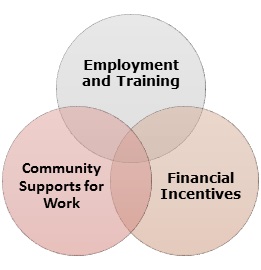
Overview
The purpose of the Jobs Plus Initiative program is to develop locally-based, job-driven approaches to increase earnings and advance employment outcomes through work readiness, employer linkages, job placement, educational advancement technology skills, and financial literacy for residents of public housing. The place-based Jobs Plus Initiative program addresses poverty among public housing residents by incentivizing and enabling employment through income disregards for working families, and a set of services designed to support work including employer linkages, job placement and counseling, educational advancement, and financial counseling. Ideally, these incentives will saturate the target developments, building a culture of work and making working families the norm.
The Jobs Plus Initiative program consists of the following three core components:

- Employment-related service: Grantees offer employment-related services to residents with a range of employment needs. This includes services such as work-readiness training, employer linkages, financial counseling, educational advancement, job placement, and employment counseling.
- Financial incentives:Targeted residents enrolled in Jobs Plus will be granted a 100 percent income disregard that will remain in place for up to 48 months.
- Community support for work:Grantees market Jobs Plus services and financial incentives to alltargeted residents in a development. The goal is to saturate communities with work-related messages and to create a culture of work.
Jobs Plus services are tailored to residents’ individual needs and are drawn from a menu of on-site and referral services. For unemployed residents, case managers will help identify short and long-term employment goals and create plans to accomplish them. Employed individuals can work with case managers to take the necessary steps to advance in the labor market.
Background: Jobs-Plus was conceived in the mid-1990s by the HUD, the Rockefeller Foundation, and MDRC, and put into practice from 1998 to 2003. The program targeted all working-age residents, attempting to “saturate” the housing developments with information, services, and incentives to support work. MDRC carefully tested Jobs-Plus in six cities and found that where the components were fully implemented, the program produced sustained positive effects on residents’ earnings. A 16 percent increase in average annual earnings was sustained up to three years after the program ended.
Current Status:
Since 2015, HUD has awarded nearly $63 million to 24 public housing agencies (PHA) to implement the Jobs Plus Program.
Resources
- MDRC has consolidated their Jobs Plus publications on this webpage.
- Drawing on lessons from the original demonstration and existing Jobs-Plus replication sites, MDRC will share operational lessons for public housing agencies responding to HUD's NOFA for the Jobs-Plus Pilot (This webcast is not sponsored by HUD.) This November 3, 2014 webcast will be archived and available for download on HUD's Webcast Archive.
- Presentations, Handouts and Webcasts
- Report: Preparing Young Adults for Manufacturing Careers
- From the Ground Up: Creating Sustainable Partnerships Between Public Housing Authorities and Workforce Investment Boards
- The importance of social networks for housing mobility outcomes
- Example of Community Supports for Work
- Grantees Share Program Strengths
- Collective Impact
- Helping Public Housing Residents Find and Keep Jobs
- The Poverty Lab: MIT Economists Pursue New Way to Study the Problem
- Solving Social Problems with a Nudge
- Scarcity: The New Science of Having Less, and How it Defines our Lives
- Starbucks is rounding up employers to hire America’s “lost generation"
- JPEID FAQ
- HOPE VI CSS Caseload Triage & Stability Index
- Case Management Training

